 Psoriasis is a pathology in which the human immune system mistakenly attacks healthy skin cells. As a result, flaky patches appear on its surface, which can be very itchy and even painful. Sometimes the disease is accompanied by inflammation of the joints and eyes.
Psoriasis is a pathology in which the human immune system mistakenly attacks healthy skin cells. As a result, flaky patches appear on its surface, which can be very itchy and even painful. Sometimes the disease is accompanied by inflammation of the joints and eyes.what is psoriasis
Psoriasis is a chronic autoimmune disease that causes red, scaly patches to appear on the surface of the skin. They are often called plaques.Psoriasis cannot be infected - it is an autoimmune disease, not an infectious disease.
Psoriasis manifests as inflammation of the skin and abnormally rapid growth and shedding of the cells (keratinocytes) that make up the stratum corneum (epidermis). Typically, it is completely renewed within a month, but in people with psoriasis, this process is accelerated many times, taking place on average within 3-4 days.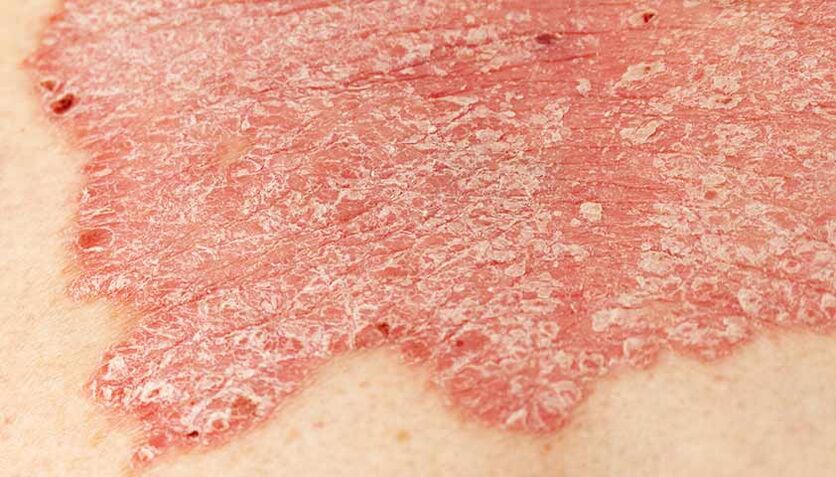 In addition to skin lesions, the disease causes joint inflammation (in about 30% of cases). Psoriasis can cause inflammation of the uvea (uveitis), but this is less common (10% of cases).
In addition to skin lesions, the disease causes joint inflammation (in about 30% of cases). Psoriasis can cause inflammation of the uvea (uveitis), but this is less common (10% of cases).Prevalence of psoriasis
Psoriasis most commonly affects people between the ages of 15 and 35, but generally, the disease can appear at any age. The first peak of pathological onset occurs at 15-20 years of age, and the second peak occurs at 55-60 years of age.On average, about 1-2% of people worldwide have psoriasis. In our country, according to the clinical recommendations of the Ministry of Health, the prevalence rate of the disease in 2021 is 243. 7 cases per 100, 000 population.Types of psoriasis
Like many chronic diseases, psoriasis is differentiated by stages, severity, and presentation.by stage
There are three stages of psoriasis: progressive, quiescent, and regression (remission).existprogress stageRed spots appear on the skin. They fuse together to form large, scaly patches with a distinct red outline at the edges—this is called erythematous erythema, a reddening of the skin caused by telangiectasia and blood flow. Corolla, or corolla. New patches are very itchy and may hurt.Traumatized areas of the skin are particularly prone to new spots: Psoriasis plaques can form quickly in places of friction, such as on clothing, and in areas where scratches or scratches occur. Doctors call this phenomenon the Kobner phenomenon.This phenomenon, also known as "isomorphic reaction, " was discovered by German dermatologist Heinrich Koebner in 1872. Doctors notice that some people with psoriasis develop new patches of skin at the site of trauma, such as after a scratch, injection, or bruise. fixed stage- Stable phase. The plaques stop growing but continue to bother and flake off. New rashes and spots usually don't appear.regression stageIt occurs when psoriasis symptoms begin to disappear. The peeling disappears and the patches lighten and flatten. Symptoms are relieved at this stage.by severity
To assess the severity of psoriasis, doctors use the PASI (Psoriasis Area and Severity Index) system - an index used to assess the severity and prevalence of psoriasis. It requires professional analysis of parameters such as the severity of erythema, infiltration, and peeling, and calculation of the area of skin affected by the rash.Based on the test results, doctors differentiate between mild, moderate and severe disease.According to table
Psoriasis can be divided into several main types based on clinical manifestations: vulgaris, inverse, seborrheic, exudative, guttate, pustular, palmar and plantar psoriasis, and erythrodermic psoriasis.Psoriasis vulgaris- One of the most common forms, accounting for approximately 90% of all cases of the disease. First, red spots appear on the skin, which turn into raised, scaly patches after a few days. As plaques develop, they coalesce into large, itchy, scaly lesions. The condition then enters a stabilization and regression phase: manifestations of the disease temporarily subside and the person's health improves.The most common site for psoriasis vulgaris is the extensor (outer) portion of the skin on the elbows and knees. Lesions can also appear on the body and scalp.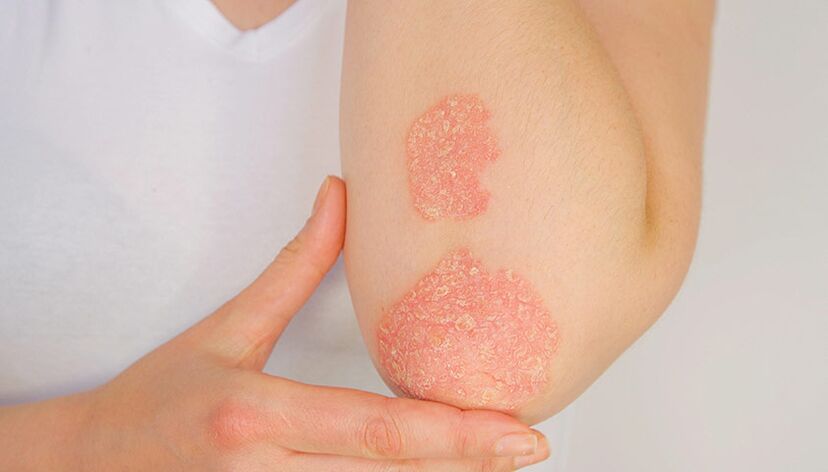 Psoriasis vulgaris on lateral elbowInverse ("reverse") psoriasisProceed in the same manner as usual. The only difference lies in the location of the lesions: instead of appearing in the extensor (lateral) part of the knees and elbows, they appear in the flexor (medial) parts, that is, under the knees, in the armpits and at the elbows. area, as well as the neck, eyelids, navel, and inguinal folds. The skin in these areas is more delicate, moist, and more likely to rub against clothing. Therefore, it may be more itchy than the usual disease, but the peeling in these areas will be less noticeable.seborrheic psoriasisIt proceeds in the same manner as normal, but the lesions are located where there are large numbers of glands that secrete sebum. This is the scalp, postauricular folds, cheeks, and nasolabial fold areas of the face, forehead, chest, and back (mainly the upper part).
Psoriasis vulgaris on lateral elbowInverse ("reverse") psoriasisProceed in the same manner as usual. The only difference lies in the location of the lesions: instead of appearing in the extensor (lateral) part of the knees and elbows, they appear in the flexor (medial) parts, that is, under the knees, in the armpits and at the elbows. area, as well as the neck, eyelids, navel, and inguinal folds. The skin in these areas is more delicate, moist, and more likely to rub against clothing. Therefore, it may be more itchy than the usual disease, but the peeling in these areas will be less noticeable.seborrheic psoriasisIt proceeds in the same manner as normal, but the lesions are located where there are large numbers of glands that secrete sebum. This is the scalp, postauricular folds, cheeks, and nasolabial fold areas of the face, forehead, chest, and back (mainly the upper part).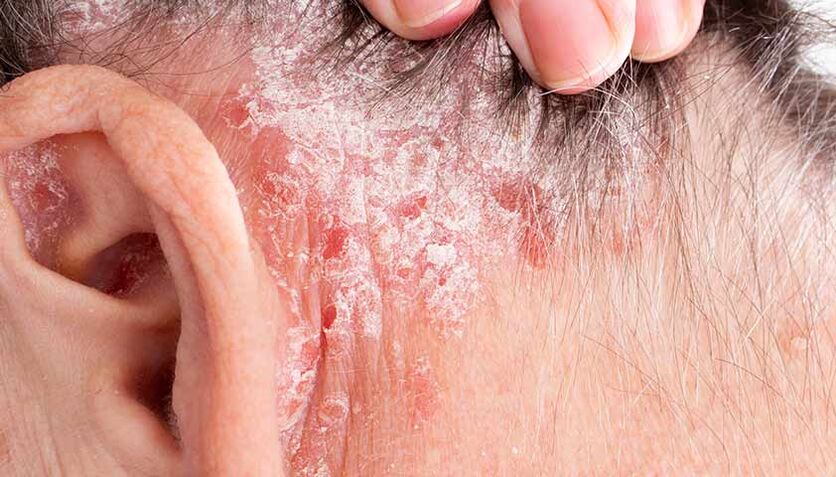 seborrheic psoriasis of scalpexudative psoriasis- A disease in which, in addition to peeling of the skin, there is an exudate from the lesions. It is a fluid that contains proteins, some blood cells, and other substances. During inflammation, exudates can be released from capillaries.The scab on the surface of exudative lesion plaques is usually dense, gray-yellow, and sometimes slightly moist. This type of psoriasis occurs most often in people with endocrine disorders: thyroid disease, type 2 diabetes, or obesity.guttate psoriasisIt does not appear on the skin as plaques, but rather as numerous papules - bright red swollen spots with flaky centers. The size of the papules is approximately 1 to 10 mm. They mainly cover the torso, arms and legs.Guttate psoriasis usually occurs in children after a streptococcal infection (such as tonsillitis). It treats somewhat better than other types of psoriasis, but in some cases it can turn into its common (vulgar) form.Pustular psoriasisIt is characterized by the appearance of multiple pustules on a red erythematous background. Pustules are structures that look very similar to papules. This type of psoriasis can be the result of an infectious disease, stress, hormonal imbalance, improper use of medications, or insufficient use of ointments. Initially, many pustules will appear on the red spots. They then coalesce into a large suppuration spot (or "pus lake").Generalized pustular psoriasis can be intolerable: fever, weakness, and severe pain and burning of the skin. At the same time, changes in the nails and pain in the joints can be observed.Psoriasis on the palms and soles of the feet- The typical psoriatic rash appears on the palms and soles of the feet, rarely in the form of localized pustular psoriasis. It can also affect and deform the nails - they become thicker, cloudy and uneven.
seborrheic psoriasis of scalpexudative psoriasis- A disease in which, in addition to peeling of the skin, there is an exudate from the lesions. It is a fluid that contains proteins, some blood cells, and other substances. During inflammation, exudates can be released from capillaries.The scab on the surface of exudative lesion plaques is usually dense, gray-yellow, and sometimes slightly moist. This type of psoriasis occurs most often in people with endocrine disorders: thyroid disease, type 2 diabetes, or obesity.guttate psoriasisIt does not appear on the skin as plaques, but rather as numerous papules - bright red swollen spots with flaky centers. The size of the papules is approximately 1 to 10 mm. They mainly cover the torso, arms and legs.Guttate psoriasis usually occurs in children after a streptococcal infection (such as tonsillitis). It treats somewhat better than other types of psoriasis, but in some cases it can turn into its common (vulgar) form.Pustular psoriasisIt is characterized by the appearance of multiple pustules on a red erythematous background. Pustules are structures that look very similar to papules. This type of psoriasis can be the result of an infectious disease, stress, hormonal imbalance, improper use of medications, or insufficient use of ointments. Initially, many pustules will appear on the red spots. They then coalesce into a large suppuration spot (or "pus lake").Generalized pustular psoriasis can be intolerable: fever, weakness, and severe pain and burning of the skin. At the same time, changes in the nails and pain in the joints can be observed.Psoriasis on the palms and soles of the feet- The typical psoriatic rash appears on the palms and soles of the feet, rarely in the form of localized pustular psoriasis. It can also affect and deform the nails - they become thicker, cloudy and uneven.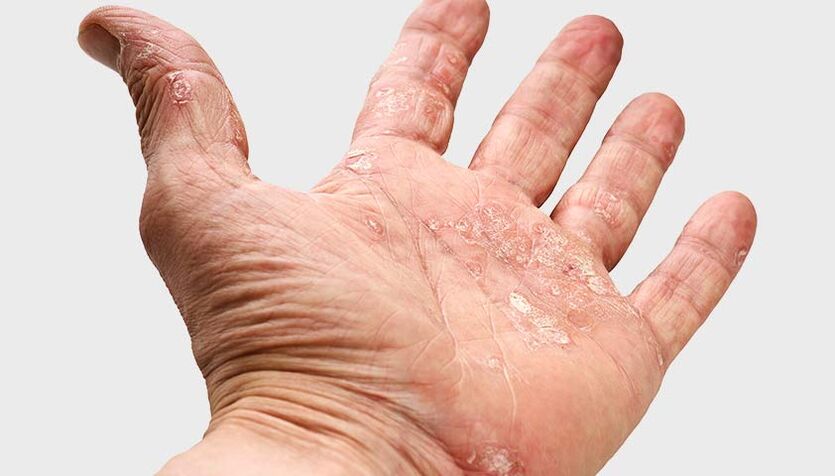 psoriasis on palmsErythrodermic psoriasisIt is very rare and is considered an extremely serious form of the disease. About 90% of the body appears red and swollen, with severe itching and pain, and the skin is swollen and peeling. The temperature often rises and the lymph nodes become inflamed.Typically, this type of psoriasis is the result of worsening of another disease due to improper treatment or adverse environmental factors (such as sunburn in advanced psoriasis vulgaris, improper use of irritating topical medications, or intravenous corticosteroids).
psoriasis on palmsErythrodermic psoriasisIt is very rare and is considered an extremely serious form of the disease. About 90% of the body appears red and swollen, with severe itching and pain, and the skin is swollen and peeling. The temperature often rises and the lymph nodes become inflamed.Typically, this type of psoriasis is the result of worsening of another disease due to improper treatment or adverse environmental factors (such as sunburn in advanced psoriasis vulgaris, improper use of irritating topical medications, or intravenous corticosteroids).Symptoms of psoriasis
The manifestations of psoriasis vary depending on the type of disease and its severity.Common signs and symptoms of psoriasis:- Red, raised, scaly patches on the skin;
- Itching of inflamed and peeling areas;
- Nail changes: needle tip indentation, thickening and fragmentation of the nail plate, separation;
- Joint pain (sometimes).
In order to get an accurate diagnosis, you need to contact a professional specialist - a dermatologist.The mechanism of psoriasis
Psoriasis is an autoimmune disease.All autoimmune diseases are related to faulty immune system function. Normally, it "scans" the body around the clock and looks for pathogen cells through foreign protein molecules, thereby distinguishing pathogen cells from the "normal" cells inherent in the body.Once a foreign protein molecule is detected, the immune system activates special immune cells called T lymphocytes, which must destroy the enemy.But for some, the IFF system can break down. As a result, the immune system begins to attack the healthy cells of individual organs or tissues, triggering inflammation in their location and harming the body it is supposed to protect in every possible way.This is what happens with psoriasis: the immune system attacks the skin. It activates T lymphocytes and "anchors" them to skin cells. Once their target is reached, T lymphocytes release inflammation-causing substances called cytokines. They cause the first symptoms: redness, swelling, itching, and pain. When you have psoriasis, skin cells divide several times faster, causing scaling and flaking.Under the influence of cytokines, an inflammatory process occurs and skin cells begin to actively divide - this is how active peeling occurs and convex spots form.Since the cell renewal process is accelerated almost tenfold, the main cells of the epidermis (keratinocytes) do not have time to form properly. Therefore, they are unable to perform their barrier function.As a result, the stratum corneum becomes permeable and no longer protects the deeper layers of the skin from the environment and moisture loss. All of these can lead to more inflammation.Until the immune system calms down, the disease will progress and symptoms will worsen.
When you have psoriasis, skin cells divide several times faster, causing scaling and flaking.Under the influence of cytokines, an inflammatory process occurs and skin cells begin to actively divide - this is how active peeling occurs and convex spots form.Since the cell renewal process is accelerated almost tenfold, the main cells of the epidermis (keratinocytes) do not have time to form properly. Therefore, they are unable to perform their barrier function.As a result, the stratum corneum becomes permeable and no longer protects the deeper layers of the skin from the environment and moisture loss. All of these can lead to more inflammation.Until the immune system calms down, the disease will progress and symptoms will worsen.causes of psoriasis
The exact reasons why psoriasis develops are not fully understood. However, many studies agree that the occurrence of psoriasis is related to genetics, lifestyle, concomitant diseases and adverse environmental factors. genetics
This disease is usually passed from parents to children. Psoriasis is mainly related to the HLA-C gene. It codes for a protein that enables the immune system to recognize its own (harmless) cells.Doctors detect a specific genetic marker in the HLA-C gene - HLA-Cw6 - more often than others in people with psoriasis. However, its presence only indicates a predisposition to disease. Not all people with the HLA-Cw6 marker necessarily have psoriasis, and not all patients diagnosed with the disease have this genetic change.lifestyle
It is thought that ongoing damage to the skin, frequent friction, sunburn and hypothermia may trigger the development of the disease. Especially if there is a genetic predisposition for the HLA-Cw6 genetic marker or a close relative has psoriasis.Other risk factors include ongoing stress, alcohol abuse and smoking - all of which can adversely affect metabolism, the function of internal organs and the immune system.Accompanying diseases
Some types of psoriasis, such as guttate psoriasis, may appear after a strep infection.Additionally, people with autoimmune diseases are at increased risk of developing lesions. These include, for example, type 1 diabetes, Crohn's disease, systemic lupus erythematosus and rheumatoid arthritis.In such diseases, the general mechanisms of the immune system are disrupted: it sees some of its own cells as foreign bodies, reacts with inflammation and destroys them. Therefore, there is an increased risk that she will mistakenly add other cells to the "blacklist".Complications of psoriasis
Psoriasis is caused by immune system dysfunction and chronic systemic inflammation. It occurs due to the ongoing attack of immune cells on healthy tissue.The peculiarity of autoimmune processes is that they can spread: the immune system is able to add other healthy cells to the list of "enemies" at any time.This can occur, for example, in the context of psoriasis, Crohn's disease, or ulcerative colitis if the immune system mistakenly attacks gastrointestinal tissue.In addition to autoimmune diseases, patients with psoriasis are also susceptible to various endocrine diseases (metabolic syndrome, obesity, type 2 diabetes), cardiovascular diseases (hypertension, heart disease) and other internal organ dysfunction. All of these are related to a chronic inflammatory process that affects hormone levels and interferes with normal metabolism.A separate complication is psoriatic arthritis. This condition occurs in approximately 30% of people with psoriasis.In psoriatic arthritis, the immune system attacks the connective tissue, most commonly affecting the joints of the lower limbs. The joint structure becomes inflamed, and the skin in the affected area may become red, swollen, and cause pain and/or stiffness when you try to bend or straighten the joint. In 10 percent of people with psoriasis, the lesions spread to the eye and develop uveitis. Inflammation of the choroid of the eye, causing vision loss and discomfort.In addition to physical complications, psoriasis can also affect a person's mental health. Changes in appearance, poor skin condition, and unbearable itching can lead to self-doubt and lead to depression.Diagnosis of psoriasis
Dermatologists diagnose skin diseases, including psoriasis.At the appointment, the doctor will ask about symptoms and when they began. Then he will ask his closest relatives: parents, brothers and sisters about skin diseases. Family history allows experts to immediately assume a possible hereditary disease - psoriasis is one of them.Doctors also ask about conditions that cause new rashes to appear and symptoms to worsen. For example, new psoriasis lesions may appear after a hot bath or prolonged exposure to the sun. In some patients, plaques appear at injection sites, scratches, or after rubbing the skin on clothing, which is a manifestation of Kobner's phenomenon that is characteristic of psoriasis.An important point in determining the diagnosis is to examine the rash. If not enough is known about the disease, a specialist can observe the rash over time and perform a histological examination (biopsy) of the skin.If your doctor is not sure that the patches on your skin are psoriasis, they will order a biopsy and histology of the skin.Histological examination of skin and subcutaneous tumorsThis study allows us to identify malignant changes in the tissue of skin tumors (nevi, papillomas, warts, age spots). For analysis, material obtained by biopsy or during surgery is used.In some cases, a specialist may check for the psoriasis triad, the main diagnostic signs of psoriasis.First, the dermatologist will take a slide or scalpel and begin gently scraping the surface of the plaque. Slight white scale peeling or stearin staining on the surface is the first sign of the triad.After all the scabs peel off, the surface of the plaque becomes smooth, shiny, and slightly moist. This is the second symbol of the underworld - the ending film.If the doctor continues to scratch the area, needle-like bleeding will appear on the surface. This is called Ospitz syndrome, or hemorrhage, and is the third sign of the psoriasis triad. After an examination and medical history, the doctor will perform laboratory tests. A clinical blood test is usually recommended - it reflects overall health. The patient was also referred for blood chemistry tests. It allows you to evaluate the function of internal organs and metabolism - over time, psoriasis can cause lesions in the cardiovascular and endocrine systems.A general urine test is also usually done. Urinary tract-related conditions may interfere with the prescribing of certain medications.General urine examination includes physical and chemical examination of urine (color, density, composition) and microscopic examination of sediments. General urine tests are used to examine the physical condition to identify pathologies of the urinary system, gastrointestinal tract, endocrine, infectious and inflammatory diseases.For the same reasons, HIV and hepatitis testing is required based on clinical recommendations. In the context of these infections, the disease may be more severe.Additionally, women should take a pregnancy test—for example, a beta-hCG blood test—in preparation for treatment. In fact, many of the systemic medications most commonly used with good efficacy in the treatment of psoriasis are contraindicated during pregnancy.This study allows you to diagnose pregnancy at an early stage and identify its complications. In induced abortion, it is used to evaluate the effectiveness of the procedure. In oncology - used to diagnose hormone-producing tumors.If you complain of joint pain, doctors may also refer patients for an MRI, CT scan, or X-ray to confirm or rule out psoriatic arthritis. If joint inflammation is diagnosed, the dermatologist will recommend testing by a rheumatologist.psoriasis treatment
If the area of skin affected is smaller, patients may use topical corticosteroid creams or ointments. They suppress inflammation and reduce the manifestations of disease.Additionally, your doctor may prescribe topical vitamin A or vitamin D analogues. These medications relieve inflammation, speed up the exfoliation of the skin's cuticles, and slow the growth of psoriasis plaques. It is also recommended to use skin moisturizers from the drugstore skin cosmetics range.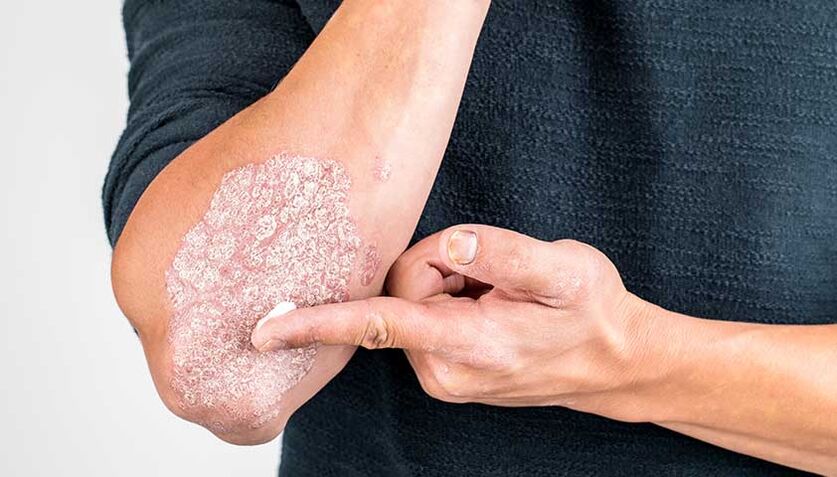 Mild psoriasis is usually treated with topical ointments and creams.For moderate to severe psoriasis, systemic treatment may be required - in the form of classic immunosuppressive and genetically engineered biologic drugs in the form of tablets or subcutaneous injections. They have dramatic effects but require careful inspection before use.Systemic corticosteroids for the treatment of psoriasis are contraindicated and can only be prescribed by a physician in certain (extremely difficult) cases and in a hospital setting. Otherwise, this treatment may cause serious worsening of the condition.Psoriasis can also be treated with phototherapy: shining a specific spectrum of ultraviolet light onto the plaques. Many physical therapy offices have special lights used for this type of treatment.The most modern and effective method of treating psoriasis is monoclonal antibodies (genetically engineered biological therapies). These drugs block certain stages of the inflammatory response, such as certain cytokines, proteins produced primarily by protective cells of the immune system that trigger inflammation and plaque growth in psoriasis.
Mild psoriasis is usually treated with topical ointments and creams.For moderate to severe psoriasis, systemic treatment may be required - in the form of classic immunosuppressive and genetically engineered biologic drugs in the form of tablets or subcutaneous injections. They have dramatic effects but require careful inspection before use.Systemic corticosteroids for the treatment of psoriasis are contraindicated and can only be prescribed by a physician in certain (extremely difficult) cases and in a hospital setting. Otherwise, this treatment may cause serious worsening of the condition.Psoriasis can also be treated with phototherapy: shining a specific spectrum of ultraviolet light onto the plaques. Many physical therapy offices have special lights used for this type of treatment.The most modern and effective method of treating psoriasis is monoclonal antibodies (genetically engineered biological therapies). These drugs block certain stages of the inflammatory response, such as certain cytokines, proteins produced primarily by protective cells of the immune system that trigger inflammation and plaque growth in psoriasis.Prevent psoriasis
There are no specific preventive measures to prevent the development of psoriasis.In general, it is recommended to maintain a healthy lifestyle: quit smoking and drinking, exercise, and eat a healthy and balanced diet.People who have relatives with psoriasis should take more care of their skin: moisturize their skin regularly, avoid hypothermia, prolonged exposure to the sun, and avoid tanning rooms. If you have a genetic predisposition to psoriasis, getting a tattoo is not recommended.forecast
Like all autoimmune diseases, psoriasis is a chronic pathology. It is impossible to completely cure psoriasis.However, prompt and properly chosen treatment can allow patients to achieve long-term remission—a period of asymptomatic disease.FAQ
How is psoriasis spread?
Psoriasis cannot be infected. It is an autoimmune disease that occurs when a person's immune system malfunctions and mistakenly attacks skin cells. The disease has a hereditary predisposition, meaning it can be inherited.
What are the symptoms of psoriasis?
In most cases of psoriasis, large, red, scaly patches appear on the surface of the skin. They can be very itchy and even painful. Most commonly, psoriasis spots appear on the elbows, knees, trunk, and scalp.Which doctor treats psoriasis?Dermatologists treat psoriasis.Can people with psoriasis enlist in the military?For mild psoriasis, it can be classified as Category B - "Limited Suitable". Draftees with moderate or severe psoriasis may be deemed unfit for military service. For each specific case, a decision will be made individually during a medical examination.

























